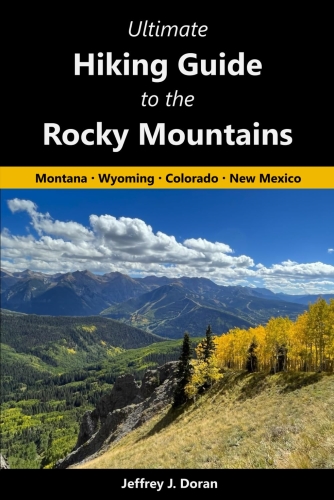New findings of elevated levels of microplastics in the highest source of the Hudson River strongly suggest that foot traffic from hikers and the clothing and gear they carry are responsible—rather than airborne deposition.
“Soft-soled trail running shoes, as well as synthetic fibers from outdoor clothing and gear, appear to be significant contributors to microplastics finding their way into these remote, otherwise pristine waters,” said Dr. Tim K. Keyes, a data scientist who helped collect water samples in New York’s Adirondack Park.
Adirondack Hamlets to Huts, in partnership with Keyes’ firm, Evergreen Business Analytics, released its
report on the results of the Return to Lake Tear Expedition, a July 2025 research trip to better understand the presence of microplastics in the Hudson River watershed.
The study revisited Lake Tear of the Clouds (elevation 4,293 feet), the Hudson’s highest source, where an earlier 2023 expedition surprisingly documented microplastic pollution in the shadow of Mount Marcy, the state’s highest mountain.
This year’s expedition added a comparative study at Moss Pond (4,252 feet), a remote, trailless body of water nearby that feeds the Hudson independently and apparently had never before been sampled for microplastics. Analysis of the samples collected revealed:
* Those from Lake Tear of the Clouds contained an average of 16.54 particles per mL, significantly higher than the 9.45 particles per mL measured in 2023.
* Moss Pond samples, by contrast, showed just 0.73 particles per mL, an order of magnitude lower than Lake Tear.
The difference: “Moss Pond is not subject to foot traffic like at Lake Tear, which is on the thoroughfare to three peaks heavily visited by hikers—Marcy, Gray, and Skylight,” said Keyes. “Almost no one goes to Moss Pond, and a lot of people go to Lake Tear of the Clouds to get to these peaks.
“There’s probably a modicum of airborne deposition involved, but from the contrast with Moss Lake it appears that a major contributor may be treadwear, the boot or shoe treads disintegrating,” Keyes said, “just like when we drive down the road and a known major source of microplastics in the front country is our tires disintegrating.”
The Return to Lake Tear Expedition was led by Dr. Joe Dadey, executive director of Adirondack Hamlets to Huts, and Keyes, with field support from multiple partners. Microplastic analysis was conducted by Parverio, Inc., which works to identify microplastics in waterways.
The rising popularity of hiking the High Peaks, and of outdoor recreation in general since the COVID pandemic, is part of the story. As recently as August 2012, when Keyes completed his 46th Adirondack High Peak, he was just No. 7,630 on the official roster of the Adirondack 46ers. The roster had taken 87 years to reach that number; but today, just 13 years later, the number of 46ers has more than doubled to over 16,000.
What are microplastics?
Microplastics are harmful particles from 1 micrometer (μm) to 5 millimeters (mm) in size. Below 1 micrometer they are known as nanoplastics.
Sources include synthetic textiles, tires, building materials, personal care products, food containers and packaging, bottled beverages, watercraft, fishing gear, and all the other places plastics are now part of our daily lives and break down over time.
We inhale microplastics when we breathe, we ingest them through drinking and eating, and they can also be absorbed through our skin.
While the impact of human, animal and environmental harm is yet to be fully understood, in humans microplastics can potentially cause inflammation and immune system dysfunction, and have been linked to cardiovascular issues, endocrine disruption, and even cancer.
In the environment they contaminate ecosystems, disrupt food chains, and potentially harm wildlife and plants through bioaccumulation.
What can be done?
As a result of their research, Adirondack Hamlets to Huts and its partners recommend the following steps to avoid bringing microplastics into watersheds:
* Encourage the use of natural fiber clothing and the most durable footwear treads in the outdoors (e.g., hard rubber vs. soft rubber soles), whenever practical.
* Wear synthetic clothing as base layers, with no- or low-shed layers outermost.
* Monitor the quality and degradation of your footwear treads (replacing them with more durable options when they’re worn).
* Practice “leave no trace” principles. If you carry it in, carry it out — and especially single-use plastics.
* Promote general awareness of the microplastics issue through outdoor clubs and gear retailers in the region.
“We believe these steps would go a long way to mitigating the distribution of microplastics in otherwise pristine areas of the Adirondacks,” Keyes said.
*******************************************************************************
From Montana to New Mexico, the American Rockies stretch for more than a thousand miles. Within this spectacular mountain range are thousands of miles of hiking trails.
With such an overwhelming number of options, how will you find and choose the most scenic and rewarding hikes?
Ultimate Hiking Guide to the Rocky Mountains takes all the guesswork out by focusing on some of the most amazing hikes across this range, and provides you with a handpicked list of options that will allow you to make the most of your trips in the Rockies:





